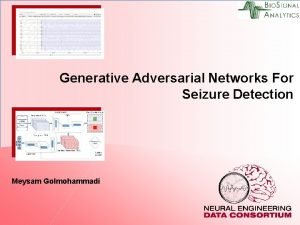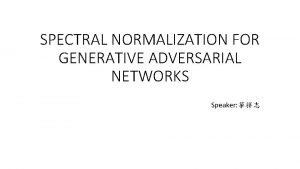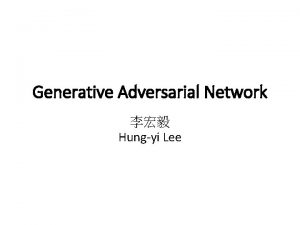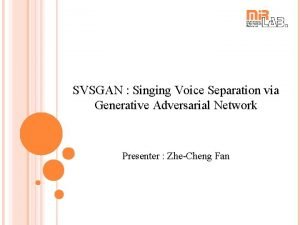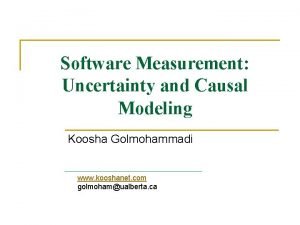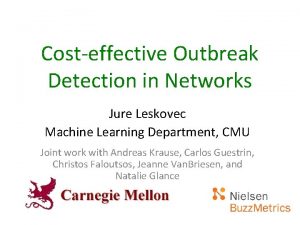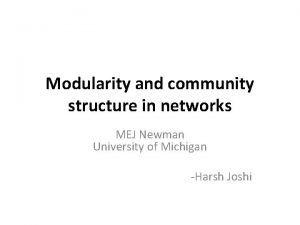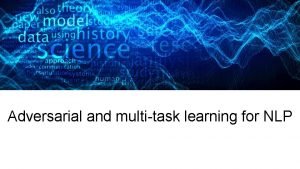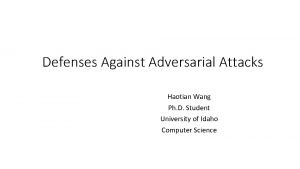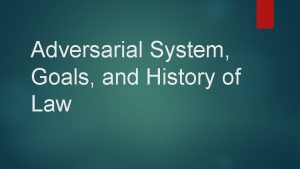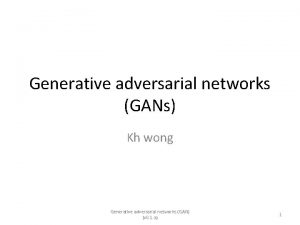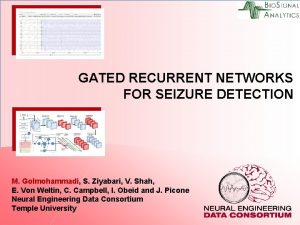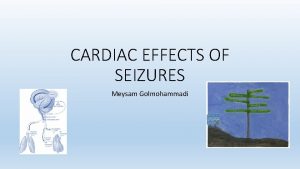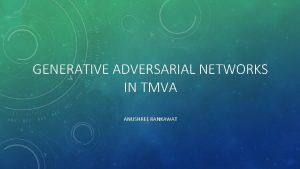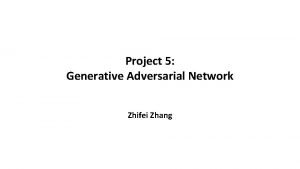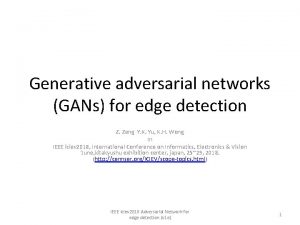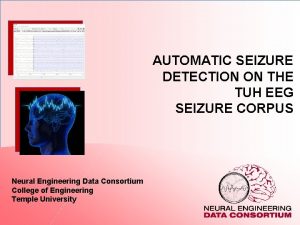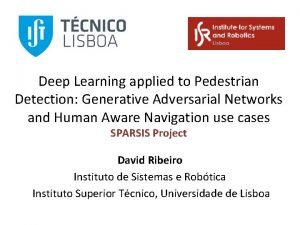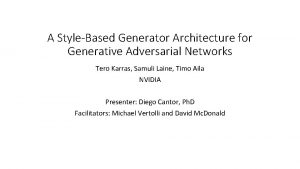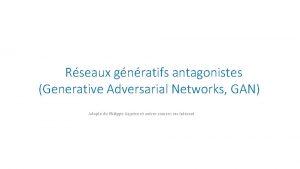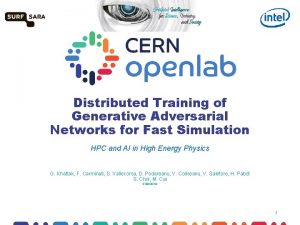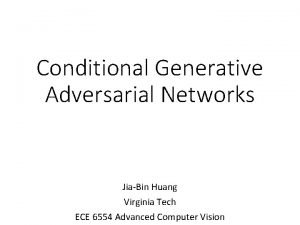Generative Adversarial Networks For Seizure Detection Meysam Golmohammadi





















- Slides: 21

Generative Adversarial Networks For Seizure Detection Meysam Golmohammadi

Introduction • The promise of deep learning is to discover rich, hierarchical models that represent probability distributions of data. • The most striking successes in deep learning have involved discriminative models, usually those that map a high-dimensional, rich sensory input to a class label. • Deep generative models have had less of an impact, due to the difficulty of approximating many intractable probabilistic computations that arise in maximum likelihood estimation and related strategies. • Generative adversarial networks (GAN's) are a recent popular technique for learning generative models for high-dimensional unstructured data. • In this framework, the generative model is pitted against an adversary: a discriminative model that learns to determine whether a sample is from the model distribution or the data distribution. • This framework can yield specific training algorithms for many kinds of model and optimization algorithm. M. Golmohammadi: Generative Adversarial Networks For Seizure Detection January 2, 2018 1

Generative adversarial network (GAN) • GAN is a new framework for estimating generative models via an adversarial process, in which we simultaneously train two models: Ø a generative model G that captures the data distribution. Ø a discriminative model D that estimates the probability that a sample came from the training data rather than G. • The training procedure for G is to maximize the probability of D making a mistake. This framework corresponds to a minimax two-player game. In the space of arbitrary functions G and D, a unique solution exists, with G recovering the training data distribution and D equal to 1/2 everywhere. • In the case where G and D are defined by multilayer perceptrons, the entire system can be trained with backpropagation. • There is no need for any Markov chains or unrolled approximate inference networks during either training or generation of samples. • Experiments demonstrate the potential of the framework through qualitative and quantitative evaluation of the generated samples. M. Golmohammadi: Generative Adversarial Networks For Seizure Detection January 2, 2018 2

The intuition behind GAN: Counterfeiters vs Police Game • The generative model can be thought of as analogous to a team of counterfeiters, trying to produce fake currency, while the discriminative model is analogous to the police, trying to detect the counterfeit currency. Competition in this game drives both teams to improve their methods until the counterfeits are indistinguishable from the genuine articles. IT’S FAKE MONEY! IT’S REAL MONEY! M. Golmohammadi: Generative Adversarial Networks For Seizure Detection January 2, 2018 3

Unsupervised Learning Using GANs M. Golmohammadi: Generative Adversarial Networks For Seizure Detection January 2, 2018 4

Noise Illustration of Unsupervised Learning by Adversarial Nets Classification Result Real World EEGs TUH EEG + Corpus x Is Discriminator Correct? Synthetic Generated EEGs M. Golmohammadi: Generative Adversarial Networks For Seizure Detection Update Models January 2, 2018 5

Adversarial Nets Training Algorithm M. Golmohammadi: Generative Adversarial Networks For Seizure Detection January 2, 2018 6

Unsupervised Learning Using DCGAN Illustration of Deep Convolutional Generative Adversarial Network (DCGAN): M. Golmohammadi: Generative Adversarial Networks For Seizure Detection January 2, 2018 7

DCGAN Structure • Generative model: Ø taking 100 random inputs, and eventually mapping them down to a matrix with size of [21, 22, 250]. Ø Composed of transposed convolutional neural networks with upsamplers. Ø Rectified linear units (Re. LU) as activation. Ø Dropout as regularization. Ø Adam as optimizer and binary cross-entropy as loss function. • Discriminative model Ø Takes in [21, 22, 250] vectors from two sources, (synthetic data) generators and (real data) features, and then decide if they are real or (synthetic) fake. Ø Composed of strided convolutional neural networks. Ø Leaky Re. LU as activation. Ø Adam as optimizer and binary cross-entropy as loss function. M. Golmohammadi: Generative Adversarial Networks For Seizure Detection January 2, 2018 8

DCGAN Stability • Pretraining of discriminator. • One-sided label smoothing. • Eliminating fully connected layers on top of convolutional features. • Replacing deterministic spatial pooling functions (such as maxpooling) with strided convolutions, which allows the network to learn its own spatial downsampling. I use this approach in the generator, allowing it to learn its own spatial upsampling, and discriminator. • Using Re. LU activation in generator for all layers except for the output. • Normalizing the input to [-1, 1] for discriminator. • Using Tanh activation in the last layer except for the output. • Using Leaky Re. LU activation in the discriminator for all layers except for the output. • Freezing the weights of discriminator during adversarial training process. Unfreezing during discriminative training. • Eliminating Batch Normalization in all the layers in both of generator and discriminator. M. Golmohammadi: Generative Adversarial Networks For Seizure Detection January 2, 2018 9

Supervised Learning Using GANs M. Golmohammadi: Generative Adversarial Networks For Seizure Detection January 2, 2018 10

Supervised Learning Using Conditional GAN (CGAN) M. Golmohammadi: Generative Adversarial Networks For Seizure Detection January 2, 2018 11

Illustration of Supervised Learning Using CGAN Classification Result Real World EEGs TUH EEG Seizure Corpus x + Is Discriminator Correct? Noise Synthetic Generated EEGs M. Golmohammadi: Generative Adversarial Networks For Seizure Detection Update Models January 2, 2018 12

Supervised Learning Using Auxiliary-classifier GAN M. Golmohammadi: Generative Adversarial Networks For Seizure Detection January 2, 2018 13

Illustration of Supervised Learning Using ACGAN Classification Result Real World EEGs TUH EEG Noise Seizure Corpus x + Is Discriminator Correct? Synthetic Generated EEGs M. Golmohammadi: Generative Adversarial Networks For Seizure Detection Update Models January 2, 2018 14

Proposed Supervised Learning Using GAN Real World EEGs TUH EEG Noise Seizure Corpus Real Seizure Fake Seizure Real Background Fake Background + Is Discriminator Correct? Synthetic Generated EEGs M. Golmohammadi: Generative Adversarial Networks For Seizure Detection Update Models January 2, 2018 15

Semi-supervised Conditional GANs • Most of the research on GAN's is focused on either the unsupervised setting, where the data is unlabeled, or on supervised setting using conditional GAN's where the goal is to learn a conditional model of the data given labels. • Given that labels are expensive, it is of interest to explore semi-supervised settings where only a small fraction of the data have labels, while a majority of the data are unlabeled. • There are limited work on semi-supervised conditional GANs. • We can use GAN's to perform semi-supervised classification by using a generator-discriminator pair to learn an unconditional model of the data and then tune the discriminator using the small amount of labeled data for prediction. • We can partition the discriminator's task of evaluating if the joint samples of training data and labels are real or fake into two separate tasks: (i) evaluating if the training samples are real or fake, and (ii) prediction of labels. • We subsequently use all the labeled and unlabeled data to assist the discriminator with the first task, and only the labeled images for the second task. M. Golmohammadi: Generative Adversarial Networks For Seizure Detection January 2, 2018 16

An illustration of Semi Supervised Conditional GANs M. Golmohammadi: Generative Adversarial Networks For Seizure Detection January 2, 2018 17

Generated EEG Samples with DCGAN M. Golmohammadi: Generative Adversarial Networks For Seizure Detection January 2, 2018 18

DCGAN Results • The results of the discriminator in DCGAN for classification of seizure vs bckg. • This is not a common approach. • In summary, I had 56% sensitivity with 210 FA per 24 hrs, using classifier of simple DCGAN with label smoothing technique, batch size of 64, and window length of 7 seconds. • This confirms the hypothesis that GAN structures can be used for automatic seizure detection task. M. Golmohammadi: Generative Adversarial Networks For Seizure Detection January 2, 2018 19

Contributions • Introducing a new model for building conditional generative models in a semisupervised setting to conditionally generate and classify data given labels by adapting the GAN framework. • Introducing a new model for building conditional generative models in a supervised setting • Investigation the potential of GANs for increasing interpretability of deep learning and debugging of the data and network based on the observations of the output of generators. • Investigating the input noise in generators. Replacing this block with a feedback from discriminator. • Applying the existing and proposed GAN frameworks for the first time on the task of automatic analysis of EEGs. • Bootstrapping GAN • Developing Recurrent-GANs • Combination of active learning with GANs. M. Golmohammadi: Generative Adversarial Networks For Seizure Detection January 2, 2018 20
 Grey matter in nervous system
Grey matter in nervous system Meysam golmohammadi
Meysam golmohammadi Generative adversarial networks
Generative adversarial networks Spectral normalization
Spectral normalization Conditional generator
Conditional generator Quantum generative adversarial learning
Quantum generative adversarial learning Singing
Singing Meysam alishahi
Meysam alishahi Koosha golmohammadi
Koosha golmohammadi Koosha golmohammadi
Koosha golmohammadi Hamming distance in computer network
Hamming distance in computer network Cost-effective outbreak detection in networks
Cost-effective outbreak detection in networks Error detection and correction in computer networks
Error detection and correction in computer networks Error detection and correction in computer networks
Error detection and correction in computer networks Community detection in networks
Community detection in networks Backbone networks in computer networks
Backbone networks in computer networks A switched wan is normally implemented as a network
A switched wan is normally implemented as a network Adversarial interview
Adversarial interview Multi task learning nlp
Multi task learning nlp Certified defenses against adversarial examples
Certified defenses against adversarial examples Hexiangnan
Hexiangnan Adversarial system law definition
Adversarial system law definition

